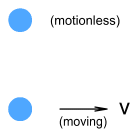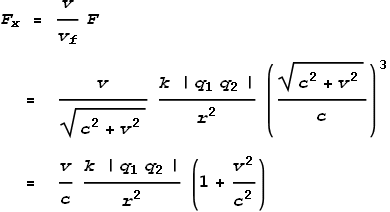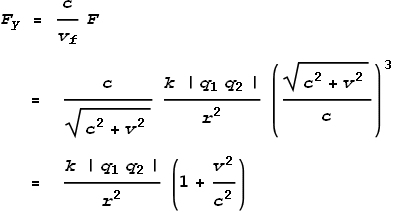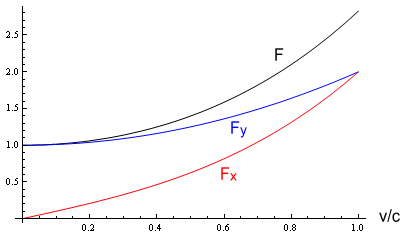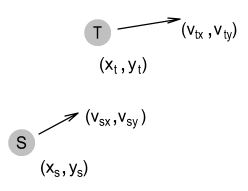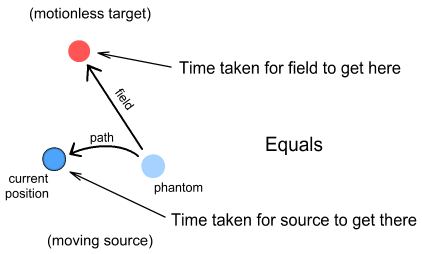The Sideways Force
Walking in the RainPreviously we looked at this force as a result of field lines moving
through a particle. Let’s now do it a bit differently. Suppose you were out walking
one fine day and it suddenly started raining. You have a raincoat with you but forgot to
bring an umbrella or hat.
Calculating the Sideways Force on Charged ParticlesDo field lines pass though charged particles (like bullets) or bounce off
them (like rain)? My guess is that they pass through. However the question is unimportant
for now since the result would be the same. So let’s just calculate what the
resulting force strength and direction might be.
The top electron is motionless and the bottom one is moving to the right
at velocity v. What will the force be on the top electron? In the chapter
on Electric Fields I introduced the concept of field velocity, which is the velocity at
which a field strikes a particle. Field velocity is a combination of light’s natural
speed and the emitting particle’s movement.
(Note: since velocity is purely relative it may be easier to imagine the
bottom electron motionless and the top one moving to the left).
Where vf is the field velocity, i.e. the speed at which the field hits the target particle (the top electron). We can now make use of the new equations given in the chapter on Electric Fields to calculate the force. These are like-charged particles so we use the push-field formula:
Where F is the net force. The direction of force will be upward and slightly to the right as shown in the vector diagram. We can now split this force into its x and y components by taking ratios of the component velocities:
Now let’s see what that looks like on a chart. For simplicity we’ll set c=k=r=q1=q2 = 1. Here is the result:
The black line is the total force, blue is the y component and red is the x component. We see that as v increases, the x component, which is the ‘sideways force’, increases. Meanwhile the net force and vertical component (y) also increase but by lesser degrees.
The sideways force for opposite chargesWhat about the sideways force from opposite particles, such as the proton and electron below?
The electron at top is motionless and the proton underneath is moving to the right at velocity v. To determine the net force we again need to determine the field velocity. This calculation has already been done – it is the same as for the two electrons above. Field velocity is the same for all charge types. But the difference here is that we will use the pull-field formula [1]:
Next we’ll split this into x and y components by multiplying the net force F by the ratios of component velocities:
Here is the result on a chart:
The black line is the total force, blue is the y
component and red is the x component. The lines are below the horizontal
axis due to the forces being in opposite (negative) directions.
The sideways force at low velocitiesThe above charts show the sideways force at velocities up to light speed. In most situations however particle motion is confined to speeds within a few percent of light. Thus it is useful to understand the general properties of the sideways force at ‘normal’ speeds. Putting aside the unusual behavior at large velocities it can be observed that for small velocities and for both the push and pull fields we get:
In other words, at low velocities (v<<c) the sideways force is directly proportional to velocity and the vertical force unchanged. For opposite charges it will be a promoting force (in the direction of a particle’s movement) and for like charges it will be retarding.
Generic equation for the sideways forceLet’s now develop a general purpose force equation that suits any arbitrary velocity and position.
The above diagram shows a Source and Target particle. Let the following terms be defined:
Where r is the distance between particles and Δx and Δy are the x and y
components of distance.
Where Δvx
and Δvy
are the differences between velocities in the x and y
directions respectively. Note that, for consistency with distances, they are in the form:
target minus source.
Where vf is the net field velocity and is
calculated from the component velocities. Here you see that c has been
multiplied by a ratio of distances to give its vector component. Particle velocity is then
subtracted (instead of added) because the Δv
terms represent the speed that the target particle is moving away from the source.
For pull-fields (from opposite-charges) the net force will be:
From this the x and y components of force can be extracted:
That’s it! Using these equations we are now able to calculate electrical forces in any situation. These are for a two-dimensional situation but extending it to three dimensions is straight forward.
Phantom particlesNow for an important concept. In describing Coulomb’s Law we refer to
the distance (r) between the source and target particles. From the view
point of the target particle however, the distance from the source particle is actually
irrelevant because the target particle reacts to the source particle’s field, not the
source particle itself.
I will call this old position of the particle a ‘phantom
particle’. It represents a historical image of the source that is seen by the target.
The position and velocity of the phantom is really what’s important in calculating
the net force on the target. Determining the phantom’s position requires knowing how
the source particle moved in the moments leading up to its current position. Here’s
how:
When the source particle is accelerating or moving along a non-straight
path this calculation can be rather tricky. It’s also possible that more than one
position could correspond to the phantom; although this would only apply to unusual
situations (e.g. high accelerations or high velocities combined with sharp curvatures). In
most situations however, we can ignore the tricky computations by assuming a
constant-velocity and straight path. This will yield the generic sideways force equations
shown above, and these are good approximations when v<<c.
Magnetism revisitedIn the chapter on magnetism where we used
the VDCL to calculate the amount of magnetic force based on current, an assumption was
made that the force between charged particles will always be directly toward or away from
each other. The above discussion on sideways forces however decrees this to not be the
case. In view of this new information then, does this mean that those magnetic force
calculations are invalid?
|
